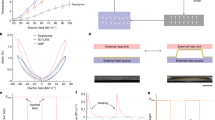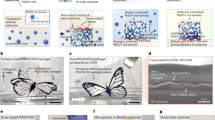Abstract
Cholesteric liquid-crystalline states of matter are abundant in nature: atherosclerosis1, arthropod cuticles2,3, condensed phases of DNA4, plant cell walls2,5, human compact bone osteon6, and chiral biopolymers7,8,9,10. The self-organized helical structure produces unique optical properties11. Light is reflected when the wavelength matches the pitch (twice periodicity); cholesteric liquid crystals are not only coloured filters, but also reflectors and polarizers. But, in theory, the reflectance is limited to 50% of the ambient (unpolarized) light because circularly polarized light of the same handedness as the helix is reflected. Here we give details of a cholesteric medium for which the reflectance limit is exceeded. Photopolymerizable monomers are introduced into a cholesteric medium exhibiting a thermally induced helicity inversion, and the blend is then cured with ultraviolet light when the helix is right-handed. Because of memory effects attributable to the polymer network, the reflectance exceeds 50% when measured at the temperature assigned for a cholesteric helix with the same pitch but a left-handed sense before the reaction. As cholesteric materials are used as tunable bandpass filters, reflectors or polarizers and temperature or pressure sensors12, novel opportunities to modulate the reflection over the whole light flux range, instead of only 50%, are offered.
This is a preview of subscription content, access via your institution
Access options
Subscribe to this journal
Receive 12 print issues and online access
$259.00 per year
only $21.58 per issue
Buy this article
- Purchase on Springer Link
- Instant access to full article PDF
Prices may be subject to local taxes which are calculated during checkout




Similar content being viewed by others
References
Small, D. M. Liquid crystals in living and dying systems. J. Colloid Interface Sci. 58, 581–602 (1977).
Neville, A. C. Biology of Fibrous Composites: Development Beyond the Cell (Cambridge Univ. Press, Cambridge, 1993).
Bouligand, Y. Twisted fibrous arrangements in biological materials and cholesteric mesophases. Tissue Cell 4, 189–217 (1972).
Livolant, F. & Leforestier, A. Condensed phases of DNA: structures and phase transitions. Prog. Polym. Sci. 21, 1115–1164 (1996).
Reis, D., Vian, B. & Roland, J.-C. Cellulose-glucuronoxylans and plant cell wall structure. Micron 25, 171–187 (1994).
Giraud-Guille, M.-M. Twisted plywood architecture of collagen fibrils in human compact bone osteons. Calcif. Tissue Int. 42, 167–180 (1988).
Yevdokimov, Yu. M., Skurdin, S. G. & Salyanov, V. I. The liquid-crystalline phases of double-stranded nucleic acids in vitro and in vivo. Liq. Cryst. 3, 1443–1459 (1988).
Van Winkle, D. H., Davidson, M. W., Chen, W. X. & Rill, R. L. Cholesteric helical pitch near persistence length DNA. Macromolecules 23, 4140–4148 (1990).
Dogic, Z. & Fraden, S. Cholesteric phase in virus suspensions. Langmuir 16, 7820–7824 (2000).
Sato, T., Nakamura, J., Teramoto, A. & Green, M. M. Cholesteric pitch of lyotropic liquid crystals. Macromolecules 31, 1398–1405 (1998).
Collings, P. J. & Hird, M. Introduction to Liquid Crystals, Chemistry and Physics 223–243 (Taylor & Francis, London, 1997).
Bahadur, B. (ed.) Liquid Crystals: Applications and Uses Vols 1–3 (World Scientific, Singapore, 1990).
Srinivasarao, M. Nano-optics in the biological world: beetles, butterflies, birds and moths. Chem. Rev. 99, 1935–1961 (1999).
Neville, A. C. Daily growth layers in animals and plants. Biol. Rev. 42, 421–441 (1967).
Neville, A. C. & Caveney, S. Scarabaeid beetle exocuticle as an optical analogue of cholesteric liquid crystals. Biol. Rev. 44, 531–562 (1969).
Caveney, S. Cuticle reflectivity and optical activity in scarab beetles: the role of uric acid. Proc. R. Soc. Lond. B 178, 205–225 (1971).
de Gennes, P.-G. & Prost, J. The Physics of Liquid Crystals 264–268 (Oxford Univ. Press, Oxford, 1993).
Kuball, H.-G. & Höfer, T. in Chirality in Liquid Crystals (eds Kitzerow, H.-S. & Bahr, C.) 86–88 (Springer, New York, 2001).
Huff, B. P., Krich, J. J. & Collings, P. J. Helix inversion in the chiral nematic and isotropic phases of a liquid crystal. Phys. Rev. E 61, 5372–5378 (2000).
Slaney, A. J., Nishiyama, I., Styring, P. & Goodby, J. W. Twist inversion in a cholesteric material containing a single chiral centre. J. Mater. Chem. 2, 805–810 (1992).
Styring, P., Vuijk, J. D., Slaney, A. J. & Goodby, J. W. Inversion of chirality-dependent properties in optically active liquid crystals. J. Mater. Chem. 3, 399–405 (1993).
Stegemeyer, H., Siemensmeyer, K., Sucrow, W. & Appel, L. Liquid crystalline norcholesterylesters: influence of the axial methylgroups on the phase transitions and the cholesteric helix. Z. Naturforsch. A 44, 1127–1130 (1989).
Dierking, I. et al. Investigations of the structure of a cholesteric phase with a temperature induced helix inversion and of the succeeding Sc* phase in thin liquid crystal cells. Liq. Cryst. 13, 45–55 (1993).
Kuball, H.-G., Muller, T. & Weyland, H.-G. Induced cholesteric phases of chiral aminoanthraquinones. Mol. Cryst. Liq. Cryst. 215, 271–278 (1992).
Kuball, H.-G., Muller, T., Bruning, H. & Schonhofer, A. Chiral induction by optically active aminoanthraquinones in nematic phases. Mol. Cryst. Liq. Cryst. 261, 845–856 (1995).
Dierking, I. et al. The origin of the helical twist inversion in single component cholesteric liquid crystals. Z. Naturforsch. 49, 1081–1086 (1994).
Dierking, I. et al. New diastereomeric compound with cholesteric twist inversion. Liq. Cryst. 18, 443–449 (1995).
Broer, D. J. & Heynderickx, I. Three dimensionally ordered polymer networks with a helicoidal structure. Macromolecules 23, 2474–2477 (1990).
Dierking, I., Kosbar, L. L., Afzali-Ardakani, A., Lowe, A. C. & Held, G. A. Network morphology of polymer stabilized liquid crystals. Appl. Phys. Lett. 71, 2454–2456 (1997).
Bouligand, Y. Liquid crystals and their analogs in biological systems. Solid State Phys. 14, 259–294 (1978).
Besseau, L. & Bouligand, Y. The twisted collagen network of the box-fish scutes. Tissue Cell 30, 251–260 (1998).
Dierking, I., Kosbar, L. L., Afzali-Ardakani, A., Lowe, A. C. & Held, G. A. Two-stage switching behaviour of polymer stabilized cholesteric textures. J. Appl. Phys. 81, 3007–3014 (1997).
Yang, D.-K., Chien, L.-C. & Fung, Y. K. in Liquid Crystals in Complex Geometries (eds Crawford, G. P. & Zumer, S.) 103–142 (Taylor & Francis, London, 1996).
Hikmet, R. A. M. From liquid crystalline molecules to anisotropic gels. Mol. Cryst. Liq. Cryst. 198, 357–370 (1991).
Heppke, G., Lötzsch, D. & Oestreicher, F. Esters of (S)-1,2-propanediol and (R,R)-2,3-butanediol — chiral compounds inducing cholesteric phases with a helix inversion. Z. Naturforsch. A 42, 279–283 (1987).
Besseau, L. & Giraud-Guille, M.-M. Stabilization of fluid cholesteric phases of collagen to ordered gelated matrices. J. Mol. Biol. 251, 197–202 (1995).
Acknowledgements
We acknowledge S. Rauch, D. Loetzsch, G. Heppke and M. Dzionara (from Stranski-Laboratorium für Physikalische und Theoretische Chemie in Technische Universität Berlin) who participated in the synthesis of the helicity-inversion chiral dopant DL6 and provided us with it. C. Bourgerette (from CEMES) participated in the material preparation for SEM-FEG investigations and, with S. Leblond du Plouy (from University Paul-Sabatier, Toulouse), helped us during the observations.
Author information
Authors and Affiliations
Corresponding author
Ethics declarations
Competing interests
The authors declare no competing financial interests.
Supplementary information
Supplementary information
Supplementary information and figure 1S (PDF 79 kb)
Rights and permissions
About this article
Cite this article
Mitov, M., Dessaud, N. Going beyond the reflectance limit of cholesteric liquid crystals. Nature Mater 5, 361–364 (2006). https://doi.org/10.1038/nmat1619
Received:
Accepted:
Published:
Issue Date:
DOI: https://doi.org/10.1038/nmat1619
This article is cited by
-
Advanced liquid crystal-based switchable optical devices for light protection applications: principles and strategies
Light: Science & Applications (2023)
-
Pancharatnam–Berry phase reversal via opposite-chirality-coexisted superstructures
Light: Science & Applications (2022)
-
Liquid crystal-templated chiral nanomaterials: from chiral plasmonics to circularly polarized luminescence
Light: Science & Applications (2022)
-
Relaxation dynamics in bio-colloidal cholesteric liquid crystals confined to cylindrical geometry
Nature Communications (2020)
-
Blue-phase templated fabrication of three-dimensional nanostructures for photonic applications
Nature Materials (2012)



